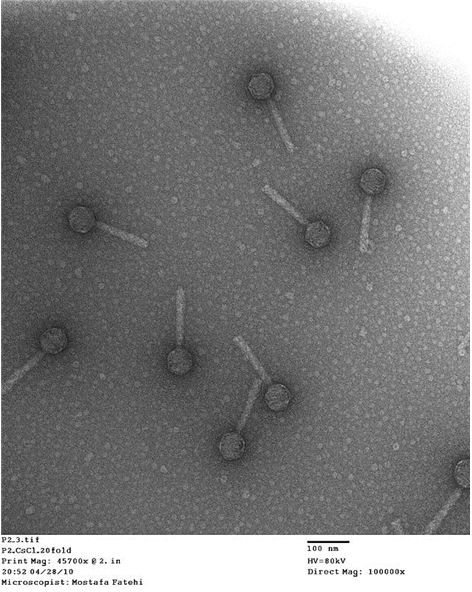Various Life Cycles of a Bacteriophage
What are Bacteriophages?
Bacteriophages (or phages) are viruses that infect bacteria. Different kinds of bacteriophages contain different material; however, all bacteriophages contains nucleic acid and protein. The nucleic acid of the phage can be either Deoxyribose nucleic acid (DNA) or Ribo nucleic acid (RNA). In phages, the nucleic acids consist of modified bases. The size and shape of a bacteriophage also varies from phage to phage. The T4 phage is the largest.
Phages also contain a head structure. Within the head is the nucleic acid, and the structure itself is composed of several copies of one or more proteins. Many phages also have a tail, through which they pass the nucleic acid during infection. The bacteriophage life cycle consists of either the lytic stage or the lysogenic stage.
The Lytic Cycle
The lytic cycle involves the infection of the host by the virus, followed by lysis, which is the bursting and death of the host cell. It also involves the release of new infectious phages. The lytic cycle is composed of the following stages:
1. Adsorption - The virus attaches itself to the host cell. Adsorption of specific receptors on the bacterial surface takes place, which can involve lipopolysaccharides, proteins or even flagella.
2. Injection of genetic material - The phages use a syringe-like motion for injection of genetic material. After finding the right receptor, the base plate is brought closer to the cell surface. Tail fibers help accomplish this, and after attachment the tail fibers shrink, releasing genetic material into the host membrane.
3. Eclipse phase - During the eclipse phase, the genetic material of the phage takes over the cell machinery of the host, and specified phage m-RNA’s, as well as proteins, are produced. The production of the host’s genetic material is halted, and the host cell becomes a “factory” for viral material. Phage DNA is also produced, follwed by the production of late m-RNA’s and late proteins. The purpose of the late proteins is the lysis of the bacterial cell.
4. Virion production - Helper proteins assemble new virions, which infect other host cells upon release. First, the base plates are assembled, followed by the tails. The head capsids are separately assembled and join the tails. Genetic DNA is placed within the head capsids. While all this is happening, the cell is drawing raw material from its environment. Also, the genes of the phage allow only viral components to be built. The host’s DNA becomes completely inactive or is destroyed.
5. Lysis Phase - In this final phase, a specific enzyme breaks down the cell wall peptodiglycan, resulting in the host cell bursting and new phages being released to search for new host cells, so the cycle can continue.
The Lysogenic Cycle
Phage cycles of P1 and lambda phages differ from the regular cycles and are known as lysogenic cycles. In the lysogenic cycle, lysis is delayed, and the phage becomes part of the host for some period of time. The virus remains dormant and can become active at any time, directing the synthesis of viral material. The following stages are part of the lysogenic cycle:
1. Adsorption - This stage is similar to the lytic cycle phase of adsorption.
2. Injection of genetic material - Similar to the lytic cycle phase.
3. Replication - In this phase, the genetic material of the virus is neither manufactured nor transcribed significantly.
4. Repression - In this phase, a protein, called a repressor, is made to bind to a specific site on the DNA of the phage. This site is called the operator. The purpose of the repressor is to shut off the transcription process of nearly all the phage genes, except the repressor gene. This results is a genome that is repressed and becomes assimilated into the host chromosome.
5. End of Lysogeny - Due to certain conditions, such as exposure of the cell to ionizing radiation or UV radiation, the cell will produce proteases, which in turn cause the destruction of the repressor protein. This results in the release of phage genes and lytic multiplication, bringing the lysogenic cycle to an end.
Phage Therapy
Phages are the most diverse of all species on planet Earth. They are found in the guts of many animals and are found in great numbers in marine setting. Oceans and seas contain an unusually high number of phages, and some estimates put the number of bacteria infected with phages in sea waters to a staggering 70 percent. Phages are extremely useful for phage therapy, as they are natural anti-bacterial agents. Historically, people were cured from diseases such as leprosy, apparently miraculously by drinking waters from sacred rivers; however, phages in the waters were actually responsible for destroying the bacteria that caused leprosy. Tests, though, have not proven, viable and more research needs to be done on the possible uses of phages and phage therapy.
References and Credits
1. https://en.wikipedia.org/wiki/Bacteriophage
2. https://apbiology.ygoy.com/52/life-cycle-of-virus-bacteriophage/
Image Credits: Wikimedia Commons/MostafaFatehi
